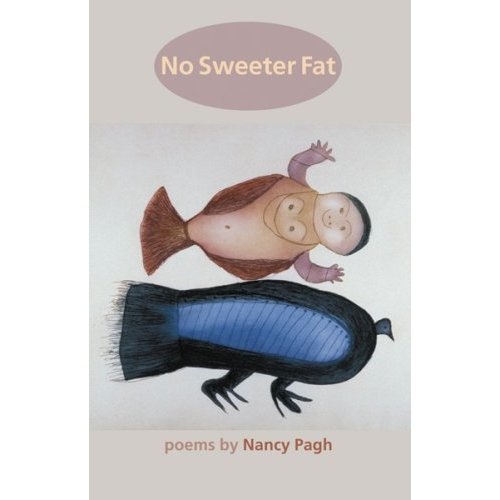Corps de l’article
Nancy Pagh’s No Sweeter Fat is a gathering of hungry poems. The volume is populated by speakers craving companionship. They are starving and striving for love, or even just for acceptance. From the wry and tragic “fat lady” poems of the first section to the melancholy renderings of anticipated love in the second to the eclectic meditations on life and death in the third, the collection is vulnerable, intimate, and honest. In the very first poem, Pagh displaces our expectations by semantically substituting “fat ladies” for “blackberries.” “There are eight hundred sixty-four poems about blackberries / published in English; where is the harm / in another?” (3). A poem should do some harm, she implies. It should have something new to say, whether we want to hear it or not.
Pagh challenges what poems are allowed to be about, and who is allowed to speak in them. In books, she observes, “there are really no fat people / of consequence” (7). “Family photos” are “[c]leverly composed to hide / The fattest daughter” (14). In No Sweeter Fat, the “fat lady” claims her voice: she sings, she prays, she takes a bath, she has cats; she goes to restaurants, to the gym, to the hospital. The heart-wrenching paradox is that the “fat lady” hungers above all for someone else to feed. Many of the volume’s most poignant poems express a yearning for human connection, a “desire to be led in the direction of someone else’s hunger” (69). In “Fat Woman with Cats” the speaker asks us “to imagine / the oceans of sweetness unleashed in this world / if every fat woman was allowed to stroke / one human” (12). The feeling of having too much to give and no one to give it to is complex, resounding in its generosity and vacuous in its loneliness.
Love and desire, from a position of body consciousness, are figured as appetite: a deep, primal hunger, “incised, protean, unassuaged / by toast” (67). Food imagery dominates this volume. The “Fat Lady Sings” “with a voice like melting apricots, / bubbling in a saucepan / with black cherries, brandy / and cinnamon notes” (5). “Prayer diets” won’t work, one poem cheekily announces, because—reason number nine—it is “[b]lasphemy, to waste German chocolate cake” (28). The sugary sweetness and “warm orange food” (19) of the “fat lady” poems transforms in the second and third sections, where memories of fishing and “all the grotesque / wonderful smells / from childhood” (73) establish the tone. The lonely speaker remains, but ocean life—halibut, perch, cod, mussels, herring, candlefish, scallops, coho, razor clams, butter clams, Greenland turbot, yellowfin sole, salmon, seals, whales—offers symbols of connectivity. Fish exemplify a sustaining cycle, where one eats another, which eats another, and another, in order to survive. Appetite is satisfied by connection.
Multifaceted, provocative, and entirely original, the “fat lady” poems of the first section are the strongest in the volume. The later sections, although they contain some real gems (“Titles of Twenty-Nine Poems I Did Not Write” and “After I Die” in particular), edge towards uninviting self-pity. “People do not want me,” the speaker concludes in one poem (57). Throughout the volume, her bitter hostility towards those who have misjudged and marginalized her risks alienating, rather than engaging, the reader. In her efforts to reverse stereotypes, she assumes that she knows what we want to hear about. She informs us that we “prefer to read of blackberries” than “fat ladies” (3), that she “sings […] despite [our] hatred of fat” (5). The anger in “Fat Lady’s Bath” is entirely directed at the interlocutor: “You will never see,” “You will never know,” “You cannot comprehend”—“Nothing has prepared you for this” (13). As a reader, I am prepared to be made uncomfortable, and I also want to be trusted. Pagh’s most stirring poems are not accusatory but self-contained, lyrical, and reflective.
No Sweeter Fat illustrates not so much a coming-to-terms with size as a simple, primitive hunger for self-expression. Energy and frankness animate this multi-dimensional depiction of desire. As the speaker negotiates a space for her voice, the poems become increasingly exuberant: stunned, caught, bowled over “because everything in this world is beauty” (83). Pagh urges us to see beauty and tenderness in unexpected places: the “magenta rhododendrons” in the “trailer park” (83), the “gorgeous sunlit spangles” in the “chalky stream” of a gull’s excrement (84). The “blackberries” in the “fat ladies” (3). She insists that we taste the distasteful and swallow the troubling truths that she unfolds, “over and over carefully like a cinnamon roll” (76). We might find them, after all, sweeter and more palatable than we thought.
Parties annexes
Biographical note
Laura Cameron is a PhD student in the Department of English at McGill University, where she studies Canadian modernist poetry. She has just completed a project on Phyllis Webb’s “struggles of silence,” and her dissertation will focus on creative silences in 20th-century poetic careers.
Parties annexes
Note biographique
Laura Cameron est doctorante au Département d'anglais à l'Université McGill, où elle étudie la poésie moderniste canadienne. Elle vient d'achever un projet sur les "luttes de silence" de Phyllis Webb ; sa thèse traitera des silences créateurs aux carrières de poètes du vingtième siècle.


